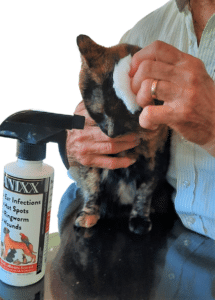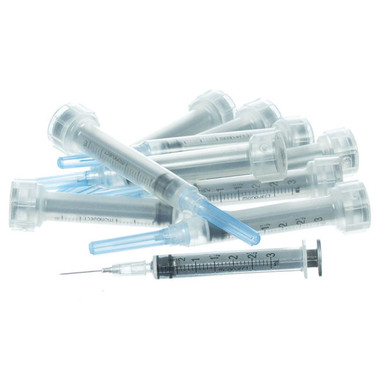What does cat side eye mean?
Estimated 0 min read
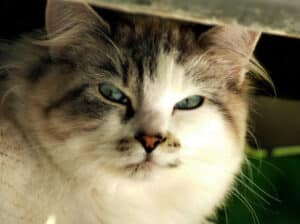
Cat side eye
Cat side eye is a fascinating aspect of feline communication that often leaves pet owners puzzled. These subtle glances can convey a wide range of emotions, from contentment to anxiety, and even signal potential health issues.
Understanding the nuances of your cat’s eye expressions can significantly enhance your relationship with your feline friend. In this comprehensive guide, we’ll explore the intricate world of cat eye behaviors and identify when eye behaviors might indicate health concerns.
By the end, you’ll have a deeper appreciation for your cat’s expressive eyes and the messages they convey.
What to know about cat side eye
- Cat eyes have unique anatomical features like the tapetum lucidum and vertical pupils, enhancing night vision and expressive capabilities
- Cat eye behaviors, including side eye, can indicate various emotions such as relaxation, curiosity, fear, or aggression
- Changes in eye appearance or behavior can signal health issues, warranting veterinary attention for conditions like conjunctivitis, glaucoma, or retinal diseases
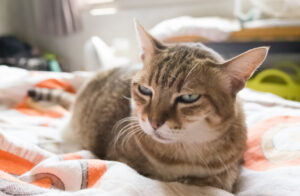
Cat eyes are distinct from humans
Understanding the Anatomy of Cat Eyes
Cats’ eyes have some unique features that set them apart from human eyes. One of the most significant differences is the tapetum lucidum, a reflective layer behind the retina. layer acts like a mirror, reflecting light back through the retina a second time. This allows cats to gather more light, enhancing their ability to see in low-light conditions.
Another key difference lies in the retina itself. A cat’s retina has a higher proportion of rod cells compared to cone cells. Rod cells are responsible for detecting light and motion, while cone cells handle color perception. This abundance of rod cells contributes to cats’ superior night vision, allowing them to see in light levels six times dimmer than what humans need. However, this comes at the cost of color perception – cats see fewer colors and less vibrant hues than humans do.
The shape and behavior of a cat’s vertical pupils also play a crucial role in their vision and communication. Their shape allows for a greater range of sizes, from fully dilated round pupils in low light to narrow slits in bright conditions. This helps cats adapt quickly to changing light levels and protects their retinas from sunlight.
Beyond their visual function, a cat’s pupils are also a key component of feline body language. The size and shape of a cat’s pupils can convey a wealth of information about their emotional state. Fully dilated pupils, for instance, can indicate arousal, whether from excitement, fear, or aggression. Conversely, constricted pupils in normal lighting conditions might suggest the cat is tense or angry.
The positioning of cat eyes on their face also contributes to their communication abilities. Cats have a wider field of view than humans – about 200 degrees compared to our 180 degrees. This positioning allows them to take in more of their surroundings at once, an advantageous trait for both predator and prey. It also means that subtle shifts in a cat’s gaze can convey significant meaning, directing attention to objects of interest or potential threats.
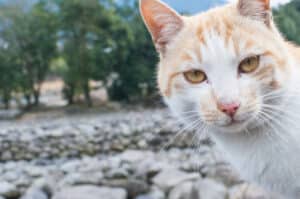
Is your relaxed or anxious?
Understanding Cat Eye Behaviors and Their Meanings
Cat eyes are not just windows to their souls; they’re sophisticated communication tools that convey a myriad of emotions and intentions. Understanding these subtle visual cues can significantly enhance our relationships with our feline companions and provide valuable insights into their well-being.
What do cat side eyes mean?
One of the most intriguing cat eye behaviors is the “side eye”. This expression can have multiple meanings depending on context and body language. When a cat appears relaxed and content while giving you a side eye, it often indicates a sense of trust and comfort in your presence. The pupils will be normal-sized or slightly constricted, and the cat’s body will be in a relaxed posture.
An alert and curious cat may also use the side eye, but in this case, you’ll notice their pupils dilate slightly as they focus on something of interest. Their ears will likely be perked forward, and their whiskers may be angled forward as well. This behavior is often seen when a cat is observing potential prey or an unfamiliar object in their environment.
However, the side eye can also indicate less positive emotions. An anxious or fearful cat might employ this look while trying to keep a perceived threat in view without directly confronting it. In such cases, the pupils will be noticeably dilated, and you may observe other signs of stress such as flattened ears or a low, crouched body posture.
When a cat is feeling aggressive or defensive, the side eye takes on a more intense quality. The pupils may be constricted to slits, and the cat’s gaze will be fixed and unblinking. This stare, especially when accompanied by a stiff body posture and possibly a growl or hiss, is a clear warning sign that the cat feels threatened and may be preparing to defend itself.
It’s crucial to note that a cat displaying side eye behavior may also be experiencing pain or discomfort. If you notice your cat frequently giving side eye glances along with other unusual behaviors like decreased appetite or lethargy, it may be time for a veterinary check-up.
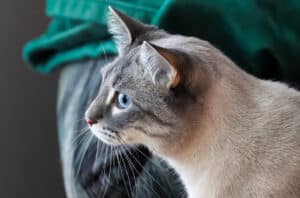
There’s meaning in a cat’s stare
Other Cat Eye Behaviors and Their Meanings
Beyond the side eye, cats use a variety of other eye behaviors to communicate. One of the most endearing is the slow blink, often referred to as a “cat kiss.” When a cat looks at you with a relaxed gaze and slowly closes and opens their eyes, they’re expressing deep trust and affection.
Wide eyes with fully dilated pupils can indicate several strong emotions in cats. This expression might signal excitement, such as when a cat is engaged in play. However, it can also indicate fear or aggression, especially if accompanied by other defensive body language.
Conversely, narrowed eyes or “squinting” in cats often signals contentment and relaxation. You might notice your cat squinting when they’re enjoying a sunny spot or receiving pets. However, persistent squinting, especially if it’s more pronounced in one eye, could be a sign of eye discomfort or infection.
Environmental factors can also influence a cat’s eye behavior. Changes in lighting can cause pupil dilation or contraction, and unfamiliar surroundings might lead to more alert or anxious eye expressions. Similarly, the presence of other animals or unfamiliar people can affect how a cat uses their eyes to communicate.
When interpreting cat eye behaviors, it’s crucial to consider the entire picture. A cat’s eyes are just one part of their complex body language. The position of their ears, the movement of their tail, and their overall posture all contribute to the message they’re trying to convey. For instance, a cat with dilated pupils could be excited about playtime if their tail is upright and quivering, or they could be frightened if their tail is puffed up and their body is crouched low.
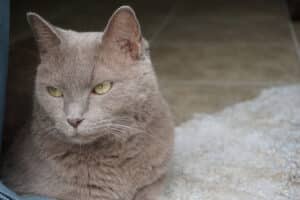
Watch out for signs of eye troubles
When to See a Vet Because of Cat Eye Issues
While cat eyes are expressive and communicative, they can also be indicators of underlying health issues.
One of the most noticeable signs of eye problems in cats is changes in the appearance of the eyes themselves. Redness, swelling, or discharge from the eyes are all potential indicators of an issue. If you notice that your cat’s eyes appear cloudy, dull, or have a change in color, this could also signal a problem. Excessive tearing or watering of the eyes, known as epiphora, is another sign to watch for.
Behavioral changes can also indicate eye problems. If your cat is squinting more than usual, pawing at their eyes, or seems to be having trouble seeing objects or navigating their environment, these could all be signs of discomfort or vision impairment. A cat that suddenly becomes clumsy, bumping into furniture or walls, may be experiencing vision loss.
One particularly important sign to watch for is anisocoria, or uneven pupil sizes. While some variation in pupil size is normal, persistent anisocoria can be a sign of serious neurological conditions.
Given the complexity of cat eye health and the potential for serious conditions, it’s important to know when to consult a veterinarian. As a general rule, any noticeable change in your cat’s eyes or vision should prompt a vet visit. This includes persistent redness, swelling, discharge, cloudiness, or changes in pupil size or responsiveness. Conditions like glaucoma or retinal detachment can progress rapidly and may lead to permanent vision loss if not treated promptly.
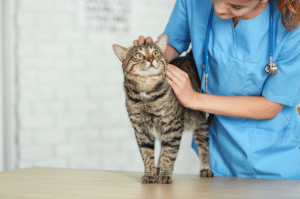
Cat getting eye check-up at vet
Regular veterinary check-ups are also important for maintaining your cat’s eye health. Your vet can detect subtle changes or early signs of eye conditions that you might not notice at home. They can also provide guidance on how to keep your cat’s eyes healthy and address any concerns you might have about your cat’s eye behaviors or expressions.
Understanding your cat’s eye language is just the beginning of building a deeper, more meaningful relationship with your feline companion.
As you become more attuned to your cat’s subtle eye expressions, you’ll find yourself better equipped to meet their needs, whether it’s offering comfort, play, or simply respecting their space.
Remember, every cat is unique, and their eye language may have personal nuances. Take time to observe and learn your cat’s individual patterns.
By doing so, you’re not just decoding their behavior; you’re strengthening the bond between you.
Banixx for Cat Lovers
For more insights on keeping your cat happy, healthy, and thriving, visit Banixx regularly. We’re committed to providing you with the latest information and practical tips to ensure your feline friend enjoys a long, contented life by your side.
Whether you’re seeking advice on caring for yourPolydactyl Cat,feline hydration health, or more tips for enriching your cat’s life, likekeeping their teeth clean, we invite you to return to Banixx to discover a treasure trove of resources and expertise. Together, we’ll continue to nurture the well-being and happiness of your beloved feline companion.
Sources
https://www.rover.com/blog/cat-eyes-meaning/
https://www.petmd.com/cat/behavior/cat-body-language
https://www.catster.com/lifestyle/cat-pupils/
https://www.drool.pet/blogs/the-why/the-surprising-meaning-behind-that-side-eye?srsltid=AfmBOoqqElIva0489y39y0tBPMxEBwtYd5HGEVavnBs-E0kS-cAKNVRf
https://www.fearfreehappyhomes.com/why-do-cats-have-vertical-pupils-the-hunts-the-thing/
https://www.thesprucepets.com/cat-talk-eyes-553942
https://www.merckvetmanual.com/cat-owners/eye-disorders-of-cats/eye-structure-and-function-in-cats



